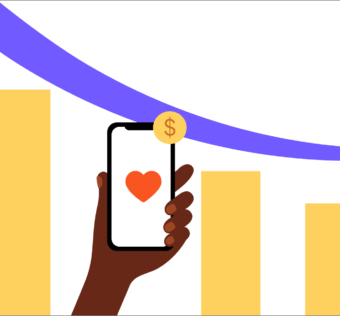Behind the Scenes of Givelify’s WIRED Interview
Recently, Givelify CEO and Founder, Walle Mafolasire, sat down for a WIRED interview to talk about the impact COVID has had on churchgoers and churches alike. WIRED magazine’s Arielle Pardes explored how the digital divide, which existed before the pandemic, has widened over the past year. She also describes how technology has been a game-changer and a lifeline for many churches, large and small.
In this WIRED interview, Walle shared how the pandemic created a new “Amazon-like way of experiencing faith.” On any given Sunday, people have the opportunity to virtually visit their home church, and sample other churches. And as people spend time discovering new places of worship, they also give joyfully to support them. Data shows about one in five givers are using Givelify to give to multiple faith-based organizations. This underscores how important a digital presence will continue to be for places of worship, even after in-person services resume.
Read additional “behind the scenes” insights from the WIRED interview below.
WIRED Interview: Compared to previous years, just how different was giving to faith-based organizations in 2020?
Walle: Prior to the pandemic, with Givelify being a mobile giving app, we were one of the few technologies that was able to quickly get insights into giving behavior when people were inside of a physical building for the place of worship and when they were not.
One of the things that we quickly noticed is that for the bulk of the transactions, donations that were happening on our platform, about half of them happened outside the walls of the church. That was pre-pandemic.
Also, one of the things that we found very interesting when we started analyzing all the data we had been collecting pre-pandemic was — you would think that Sunday would just naturally, lend itself to a higher number of gifts. But interestingly, we also found out that a little over 40 percent of all the contributions that we were seeing were happening on days other than Sunday. And keep in mind, again, this is unprompted.
So, there’s a very interesting pattern that we were seeing pre-pandemic.
Now, fast forward to the pandemic. It’s like all of a sudden you go from 47 percent of the transactions happening outside of the church building to 97 percent, 98 percent of that happening outside of the church building. And so we thought that was very, very interesting.
One of the other things we started seeing from our data, we saw the amount of generosity kept going up on our platform. And of course, we were curious. Is it just an anomaly? Or is there something more to this? And that was what led us to doing the research that was summarized in the Giving in Faith report.
At a time when there was so much uncertainty and job losses everywhere, one of the things we saw held steady was the generosity of Americans. It held steady for those first a few months of the height of the pandemic and the shutdowns, as you could see in the report.
But in the months since then, one of the things that we’ve noticed, that while the total amount of giving continues to stay steady, maybe even slightly increase, the number of people giving is on the decline.
So, what we are seeing is the average size of the gift is getting bigger, but the number of people doing the giving is a little bit on a decline.
WIRED Interview: What does that mean to be in this digital divide and to have that stark difference between — you either are getting your donations digitally or you’re not getting donations at all?
Walle: What we saw from the research is that those churches who embraced digital prior to the pandemic saw their giving was consistent. As a matter of fact, many of them reported it actually increased. About 50 percent reported it was about the same. Twenty five percent of churches said giving actually shot up.
And when you dig into that some more, we discovered what I call the current “Amazon-like” faith experience.
So what do I mean by that? In the past, on Sunday I would wake up in the morning, brush my teeth, my wife and my son would get dressed, we would drive to our church, we’d sit there for about 1.5 hours, and, we come back home.
Today, (you’re not allowed to judge me), my experience is, I wake up, I may or may not brush my teeth, but I start experiencing different faith experiences when I log onto my computer.
So, I go from this monogamous relationship that I used to have with my church to — for lack of a better term — a polygamous relationship that I have with multiple churches. And on the church side, they’re picking up more and more people like me, who are enjoying that faith fantasy. I call them “fantasy faith” experiences. I’m curious about that other church, what do they do, why is the pastor so popular? I’m curious. And I could just do it with a click. So, not only is my home church still getting my giving, but through all of this, my fantasy, other churches, are getting a piece of my giving as well.
We saw that for the churches that saw giving increasing, it was actually coming from the ability to reach a wider audience. On the donor side of things, we noticed that roughly about 20 percent of our weekly transactions were one person giving to multiple organizations.
When it’s all said and done, this is going to be the new norm, even when we return to in-worship services. I don’t think that’s going to go away.
WIRED Interview: How do churches need to adapt so that they can survive and thrive in this new sort of “fantasy faith” world?
Walle: Churches for the longest have figured out what the experience needs to look like when you have a visitor coming into the building for the first time. And those of them who have really figured out how to translate what they did in the physical building to the virtual world, (of being very intentional about how do we create experiences and connections to that first time person). Those of them who figured it out are doing amazing at it. Because they keep bringing you back. They keep bringing you back. You want to watch them.
I’ve been to some of these churches that are saying, “Hey, if it’s your first time joining us, please type your name in the Zoom, want to welcome you.” And right after the service, I’ve been invited into a private Zoom room, to meet with the pastor.
Then, I start getting voicemails from the pastor, checking up on me to see how I’m doing in this pandemic.
And if I’m not answering the phone, he’s leaving a voicemail to say, “Hey, Walle, I’m praying for you, just want you to know that I’m here if you need anything.”
And so, I think a lot of them who really figured out how to carry the same things they did in the worship place into the virtual world are finding ways to connect with these new audiences. They are building and nurturing that relationship in very powerful ways. I think that will continue to go on as we look into the future.
We hope you take a moment to read the full WIRED article here to learn more about the digital divide many churches still face today. Givelify connects over 45,000 churches and nonprofit organizations with a growing community of generous donors. Sign up for free, whether you’re a donor or an organization.




